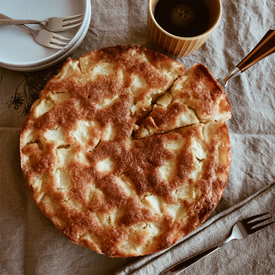Recipe - Torta di Mele della Nonna
From forbidden fruit to a panacea for good health, the apple has accompanied us since ancient times and is one of the most widespread fruits all over the world. Discover a few interesting facts about apples and try our recipe for a traditional apple cake from Italy.
Origin of the Apple
The apple has been part of our diet since time immemorial. In fact, the actual fruit of the apple tree (Malus domestic), a plant belonging to the Rosaceae family native to Central Asia, is the core of the apple. Although in common parlance we call it a fruit, in botanical terms the apple ( as well as pear and strawberry) is considered to be a "false fruit". It was already known to ancient civilisations including the Mesopotamians, Egyptians, Greeks and Romans. In addition to being a food, it was also used as a natural remedy to treat various ailments. After a period of agricultural neglect following barbarian invasions, apple trees for a long time flourished only in the wild. It was around the 15th century that they began to be cultivated again thanks to the work of monks in monasteries who created high-quality grafts and varieties. It continues to be one of the most widely cultivated fruit trees to this day. There are around 7000 varieties of apples originating in different countries and vary by colour, size, texture, flavour and nutrients.
Myths, Legends and Symbolism
There are innumerable myths surrounding the apple. The first one that comes to mind is the "forbidden fruit" in the Garden of Eden. Even though there is no mention in the Bible of the "Tree of Knowledge" being an apple tree, this belief was widespread in Western Europe starting in the Middle Ages. This was consequently transmitted to the figurative arts. Then there is the "apple of contention" given by Paris to Aphrodite which led to the famous Trojan War. Greek mythology is teeming with myths where the apple plays a starring role. As we approach more modern times, we have the famous apple that fell from a tree and inspired Sir Isaac Newton's law of gravity. Or the apple of William Tell, the famous Swiss hero and skilled archer, who saved his little son's life by precisely hitting an apple on his head. How can we not mention the poisoned apple given to Snow White by the evil witch? Nowadays New York City is known as the Big Apple. The origin of the moniker is probably due to a variety of factors but it became truly popular after it was used in a promotional campaign by the New York tourism authorities in the 1970s. The apple was also the symbol used by Steve Jobs for the company he founded (Macintosh) which was subsequently named Apple. We could go on and on and on...
Origin of the Apple Pie
Being such an ancient fruit there are countless recipes around the world featuring apples - both sweet and savoury. Let's talk briefly about one specific type or recipe, namely cakes. Among the first written recipes for apple cakes, there is one dating back to around 1300 by French chef Guillaume Tirel, (known under the pseudonym Taillevent) about a "tarte aux pommes". His recipe was more or less similar to the modern American apple pie but included onions in the filling, an ingredient that was often used in those days to give sweetness to dishes. Let's not forget that sugar used to be very rare and expensive and was considered to be a medicine. Several sources suggest that the apple pie in fact originated in England and was taken to America during colonial times by settlers. It gained rapidly in popularity so much so that it is now practically considered a symbol of American cuisine and culture - "as American as apple pie". It is difficult to establish exactly when the current version of apple pie was invented. What is certain is that this dish was invented before refrigeration simply because it was a great way to preserve fruit!
As Easy as Pie
Since the apple is so widely available all over the world, every culture has its own recipes for apples using other locally available ingredients and different cooking methods. Let's take a look at a few popular ones.
- American Apple Pie - A shortcrust pastry filled with apples flavoured with cinnamon and served hot with a scoop of vanilla ice cream.
- Apple Strudel (German: Apfelstrudel): A typical Austrian pastry consisting of strudel dough filled with chopped apples, raisins and buttered breadcrumbs. It is enjoyed both hot and cold.
- Tarte Tatin - A delicious upside-down cake from France. It owes its name to the Tatin sisters who, as the legend goes, invented it by chance in their restaurant. Apple pieces are caramelised with butter and sugar, covered with a layer of shortcrust pastry and baked.
- La Veja di Mele - A traditional Swiss dessert that includes a crisp dough around an apple filling dipped in soft cream.
- Torta di Mele della Nonna - A classic Italian cake that is perfect with a cup of coffee or tea. As can be expected, there are many recipes for this traditional and extremely popular cake. How about trying ours?
Our Recipe for Torta di Mele della Nonna
The type of apple used is up to you - Golden Delicious, Renette and Granny Smith are good options if you enjoy slightly tart flavours. This is a versatile recipe that can be made "lighter" by reducing the amount of sugar and butter.
Ingredients:
- 1 kg apples, peeled and cut into pieces
- 250 g sugar (200 g for the lighter version)
- 200 g flour
- 150 g butter (100 g for the lighter version)
- 2 eggs
- 7 g baking powder
- 1/2 teaspoon powdered cinnamon
- a dash of milk if necessary
Method:
Melt the butter (for example in the microwave). Beat the eggs with the sugar until frothy. Add the sifted flour with the baking powder. Mix it into a smooth batter. Next stir in the apple pieces along with the melted butter. If the batter is too thick, add a little milk. Transfer the batter to a greased cake tin and bake in a convection oven at 180°C for 25 minutes.
Let it cool completely before serving.
Recipe and photo by bm_thelittlecaper
Related products
-
 4.8 (18)
4.8 (18)Sonnentor Organic Ceylon Cinnamon, Ground, 40 g
- Sweet and mild flavour
- Fresh spice
- Versatile
£2.45 (£61.25 / kg)Delivery by January 07
-
 5.0 (1)
5.0 (1)Classic Ayurveda Organic Cinnamon - Ground, 80 g
- Ground ceylon
- Low coumarin content
- Hot, sweet & astringent
£9.15 (£114.38 / kg)Delivery by January 07
-
 5.0 (1)
5.0 (1)Sapore di Sole Organic Soft Wheat Flour Type 1, 1 kg
- Single variety wheat flour
- Stoneground with hydropower
- Contains many valuable nutrients
£2.35 (£2.35 / kg)Delivery by January 07
Magazine Articles:
Discover Piccantino:
-
Great Britain: Free standard delivery from £69.90
-
Free
returns More than 11.050 products
Secure payments
with SSL encryption technology


